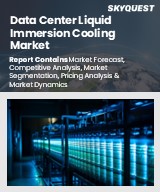
Report ID: SQMIG45D2139
Skyquest Technology's expert advisors have carried out comprehensive research on the data center liquid immersion cooling market to identify the major global and regional market trends and growth opportunities for leading players and new entrants in this market. The analysis is based on in-depth primary and secondary research to understand the major market drivers and restraints shaping the future development and growth of the industry.
Surge in AI and High-Density Computing Workloads
Expansion of Hyperscale and Edge Data Centers
High Capital Expenditure and Infrastructure Overhaul
Lack of Standardization and Compatibility Issues
REQUEST FOR SAMPLE
Global Data Center Liquid Immersion Cooling Market size was valued at USD 789.8 Million in 2023 and is expected to grow significantly from USD 986.7 Million in 2024 to USD 6,102.3 Million by 2032, growing at a significant CAGR of 25.6% in the forecast period (2025-2032).
Global data center liquid immersion cooling market's competitive dynamics are transforming rapidly with organizations adopting cooperative initiatives to drive greater demand for effective thermal management across high density applications. February 2025 was a highlight with one such large development being witnessed when Asperitas teamed up with Cisco as part of Cisco Engineering Alliance. This joint approach combines Asperitas' internally developed immersion cooling technologies, Perpetual Natural Convection (PNC) and Direct Forced Convection (DFC), with Cisco's Unified Compute System (UCS). The coupling of proven cooling hardware and best-of-breed compute infrastructure will enable the collaboration to provide streamlined, scalable, and power efficient solutions tailored for next generation data center applications. This work enables easier adoption in a range of deployment sizes, from edge to hyperscale, reducing implementation barriers and accelerating market reach of immersion-based systems. 'Fujitsu Limited', 'Delta Power Solutions', 'DUG Technology', 'Green Revolution Cooling Inc.', 'Submer Technologies SL', 'LiquidStack Holding B.V.', 'Asperitas Company', 'LiquidCool Solutions', 'Midas Immersion Cooling', 'Iceotope Technologies Ltd', 'Wiwynn Corporation', 'DCX Polska sp. z o.o.', 'STULZ GmbH', 'Schneider Electric SE', 'Alfa Laval', 'Airedale International Air Conditioning', 'Engineered Fluids', 'BOYD', 'Kaori Heat Treatment Co., Ltd.', 'Teimmers'
The growth in AI, machine learning, and blockchain technologies has been a major driving force behind the demand for high performance computing (HPC) hardware, including GPUs and TPUs. These devices produce significant heat, so air cooling techniques are not sufficient. With workload densities above 25–30 kW per rack, immersion cooling is the best option, handling heat efficiently and maximizing Power Usage Effectiveness (PUE). It allows businesses to utilize computationally intensive applications with lower power consumption and operational expense.
Short-Term: In the near term, liquid immersion cooling in the data center is picking up speed as a solution because of the thermal management issues precipitated by AI, ML, and GPU workloads. Hyperscalers and enterprises are testing immersion cooling in targeted deployments to address rack densities above 30 kW. Short term energy efficiency benefits, lower hardware failure rates, and ESG pressures are driving early adoption. The trend is especially significant in North America and the Asia-Pacific region, where demand for infrastructure capable of supporting AI is currently greater than the cooling capacity of conventional air-based systems.
Why is North America Leading Data Center Liquid Immersion Cooling Market in 2024?
Want to customize this report? This report can be personalized according to your needs. Our analysts and industry experts will work directly with you to understand your requirements and provide you with customized data in a short amount of time. We offer $1000 worth of FREE customization at the time of purchase.
Feedback From Our Clients

Report ID: SQMIG45D2139
sales@skyquestt.com
USA +1 351-333-4748